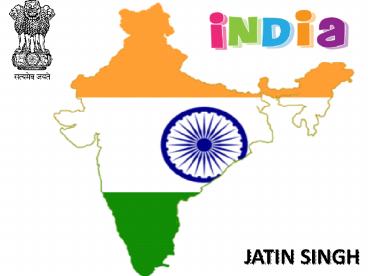India Population 2017 - PowerPoint PPT Presentation
Title:
India Population 2017
Description:
IndiaPopulation2017.in sharesthe most accurate population of Indian states and its city in 2017.For more details visit – PowerPoint PPT presentation
Number of Views:144
Title: India Population 2017
1
JATIN SINGH
2
Tables of Content
- HISTORY OF INDIA
- Ancient India Timeline
- RELIGION
- CULTURE
- ECONOMY
- POLITICS
- POPULATION
- REFERENCE
3
History of India
- India is a land of ancient civilization. India's
social, economic, and cultural configurations are
the products of a long process of regional
expansion. Indian history begins with the birth
of the Indus Valley Civilization and the coming
of the Aryans. These two phases are usually
described as the pre-Vedic and Vedic age.
Hinduism arose in the Vedic period. - The history of this astonishing sub continent
dates back to almost 75000 years ago with the
evidence of human activity of Homo sapiens.
Amazingly, almost five thousand years ago, the
inhabitants of the Indus Valley Civilization had
developed an urban culture based on commerce and
sustained by agricultural trade.
4
Ancient India Timeline
5
RELIGION
- HINDUISM
- ISLAM
- SIKHISM
- JAINISM
- BUDHISM
- CHRISTIANITY
- THE PARSIS
- THE JEWS OF INDIA
- CASTE SYSTEMS IN INDIA
6
CULTURE
- Indian cultural history spans more than 4,500
years. During the Vedic period.(c. 1700 500
BCE), the foundations of Hindu philosophy
mythology theology and literature were laid, and
many beliefs and practices which still exist
today, suchas dharma, karma, yoga, and mok?a,
were established. India is notable for
its religious diversity with Hinduism, Buddhism, S
ikhism, Islam, Christianity, and Jainism among
the nation's major religions. The predominant
religion, Hinduism, has been shaped by various
historical schools of thought, including those of
the Upanishads, the Yoga Sutras,
the Bhakti movement and by Buddhist philosophy.
7
ECONOMY
- According to the International Monetary
Fund (IMF), the Indian economy in 2015 was
nominally worth US2.183 trillion it is the
7th-largest economy by market exchange rates, and
is, at US8.027 trillion, the third-largest
by purchasing power parity or PPP. With its
average annual GDP growth rate of 5.8 over the
past two decades, and reaching 6.1 during
201112, India is one of the world's
fastest-growing economies .However, the country
ranks 140th in the world in nominal GDP per
capital and 129th in GDP per capita at PPP.Until
1991, all Indian governments followed protectionis
t policies that were influenced by socialist
economics. Widespread state intervention and
regulation largely walled the economy off from
the outside world. An acute balance of payments
crisis in 1991 forced the nation to liberalize
its economy. since then it has slowly moved
towards a free-market system by emphasizing both
foreign trade and direct investment inflows.
India's recent economic model is largely
capitalist.India has been a member of WTO since
1 January 1995.
8
POLITICS
- India is the world's most populous democracy. A
parliamentary republic with a multi-party system
it has six recognized national parties including
the Indian National Congress and the Bharatiya
Janata Party (BJP), and more than 40 regional
parties. - In the Republic of India's first three general
elections, in 1951, 1957, and 1962,
the Jawaharlal Nehru -led Congress won easy
victories. On Nehru's death in 1964, Lal Bahadur
Shastri briefly became prime minister. - In the 2014 general election, the BJP became the
first political party since 1984 to win a
majority and govern without the support of other
parties. The Prime Minister of India is Narendra
Modi, who was formerly Chief Minister of Gujarat.
9
POPULATION
- At the census 2001, out of 1028
million population, little over 827 million
(80.5) have returned themselves as followers of
Hindu religion, 138 million (13.4) as Muslims or
the followers of Islam. - 24 million (2.3) as Christians
- 19 million (1.9) as Sikh.
- 8 million (0.80) as Buddhists
- 4 million (0.4) are Jain.
- If current growth rates continue, India will have
1.63 billion people by 2050 and will surpass
China, said a report. India on Saturday recorded
a population of 127,42,39,769 which is growing at
a rate of 1.6 per cent a year, and could make the
country the most populous in the world by 2050.
10
REFERENCE
- https//en.wikipedia.org/wiki/India
- 2. http//indiapopulation2017.in/































